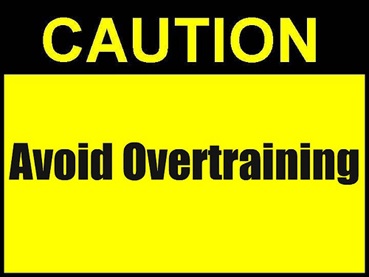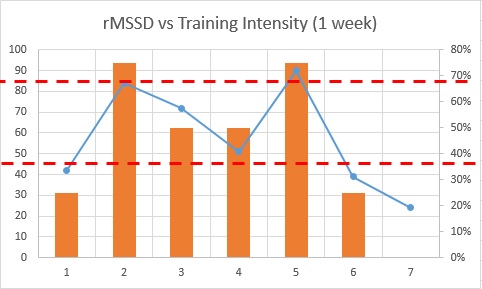Overtraining - The Next Level:
Using HRV to get the most 'bang for your buck'
Alan Couzens, MS (Sports Science)
Feb 2nd, 2015

This is part of a 5 part series on using Heart Rate Variability to guide your training. You can find part 2 here, part 3 here, part 4 here& part 5 here.
In previous articles I’ve looked at overtraining and some of the simple tests that you can use to detect it. In this piece, I’m going to turn it up a notch, both in the sophistication of testing explored and in just how broad we make our definition of ‘over training’.
When we think about it, over training means, quite literally, doing more training than is required to reach a given level of fitness or result. In other words, it is not quite as ‘black and white’ as popularly believed. An athlete may well and truly be over-training before he is relegated to a vegetative mess who can’t make it to practice in the morning. Indeed, the ability of the astute coach to identify these preliminary indicators that an athlete is not ready to absorb the day’s scheduled programming may make all the difference in avoiding these more serious states!
This preliminary identification of an athlete being ‘just a little too tired’ to benefit from hard training is very much where coaching art meets coaching science and, until very recently, art was winning!
Overtraining indicators in the literature were semi-reliable at best – things like resting T:C ratios, resting heart rate measures and bodyweight fluctuations tended to respond clinically only at the point of severe over-training, i.e. too little, too late to be of truly practical use. Psychological indicators – POMS inventories etc showed the most promise as an early warning system but, even then, the practicality of having an athlete complete psychological inventories on a sufficiently frequent basis is questionable. So, early detection of over-training was largely left to something ‘looking a bit off’ in the trained eyes of the coach.
In very recent years, some metrics have shown promise as potential practical early detectors of overtraining. One of these is Heart Rate Variability or the variability in timing between R-R spikes in an EKG measurement. For some great background reading on HRV, please check out this series of articles from Endurance Corner’s resident cardiologist, Dr. Larry Creswell
Not only has HRV shown promise as an indicator of ‘clinical over-training’ but studies have also examined the relationship between HRV and a diminished training response (e.g. Hautala et al., 2003, Vesterinen et al., 2011), with some pretty interesting conclusions.
The study by Vesterinen et al., 2011, in particular, is interesting for the difference it shows in an athlete’s readiness for different types of training based on their HRV numbers. For example, the figure below shows the difference they observed in training response (% change in VO2peak) based on heart rate variability (in this case, total power – TP in ms^2).

For ‘intense training’ – training with approx. ¼ of the work above the athlete’s aerobic threshold (chart on the right), there is a clear relationship between heart rate variability and the response to the training load. In other words, if we want an athlete to get the most ‘bang for their buck’ during intense training, we want HRV to be high.
On the flipside, for easy aerobic training, there is only a very mild correlation between the athlete’s HRV and their readiness to respond to the training load &, if anything, this correlation is slightly negative. In other words, when the athlete’s HRV is a little lower than average, they may actually be in the best position to respond to aerobic work in and around the AeT.
I’ve been playing around a little with this concept in my own training and with that of a few athletes I work with in the following ways:
- If HRV is significantly higher than average (within the top 25% of measured values for that athlete), I will plan an ‘intensity day’. The nature of this will change with the phasing of the periodization plan but these are the ‘key sessions’ of the week.
- If HRV is normal (within the middle 50% of values measured) I will plan a regular aerobic training day, with a focus on work in and around the athlete’s AeT.
- If HRV is significantly low (lowest 25% of measured values) I will plan a recovery day. If an athlete is really ‘bottoming out’ with a ‘red light day’ of values in the bottom 3% of all values measured, I will plan a true rest day.
An example of this over the course of a training week is shown below (with the blue line indicating daily HRV measurements – rMSSD & the column chart indicating the relative intensity of training for that day – arbitrary units)

The 2 red dashed lines represent the 25% cut-offs for high and low values (with a value at or above 84ms falling in the top 25% of all values measured and a value of <44ms falling in the bottom 25% of all values measured for this athlete).
Monday (day 1) - rMSSD was 31ms – significantly lower than average, after a solid weekend so we planned an easy day.
Tuesday (day 2) - HRV bounced backed to a high 92ms so we did the key loading day of the week.
Wednesday/Thursday (days 3 & 4) - HRV was back down to normal ranges so we did normal AeT days.
Friday (day 5) - HRV bounced back to a high level indicating readiness to load so we did the second key intensity day of the week.
Saturday (day 6) - HRV was low again so we planned another recovery day.
Sunday (day 7) - Despite yesterday’s recovery, HRV was still low and was approaching the bottom 3% of all recorded values (not shown) of 18ms so we took a day off.
Obviously, this approach demands a certain level of flexibility within the week and that may be a limiter for some working athletes but I would almost go so far as to argue for the benefit of opening up some space within the week (i.e. cutting back slightly on total load if needed) to attempt to adopt this approach.
There are a number of software packages and ‘apps’ on the market that (presumably) follow a similar logic to ‘optimize training’ but their algorithms tend to be proprietary so I’m not really sure what is going into them and, to be frank, I haven’t been encouraged by the ones that I have trialed – I’ve been told I was ‘ready for hard work' in the midst of sickness etc. The raw numbers seem to be much more reliable, at least when observed over a few days with respect to the athlete’s baseline.
Of course, the problem with not using the ‘ready made’ apps is that there is a lot of time overhead in the data analysis so I’m putting my new (still very rudimentary) computer skills to good use to try to address that issue and make the application of the above principles easier and more widespread. After all, the easier it is to use, the more data I get back so it’s a win-win! :-) More to come on that front....
Until then…
Train smart,
AC
Tweet**************************
Don't miss a post! Sign up for my mailing list to get notified of all new content.
**************************
